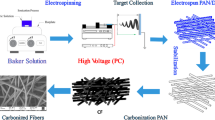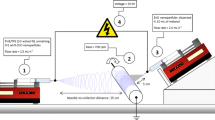Abstract
Electrospinning (ES) of polymer solutions generates non-woven webs of nanofibres. The fibre diameter ranges between 10 nm and 1 μm depending on the operating conditions. Surface functionalisation can be performed by the use of suitable additives. Detailed characterisation of the molecular composition at the fibre surface is a key issue. Biodegradable nanowebs with potential antibacterial activity have been prepared by ES of solutions containing polycaprolactone (PCL) and a functionalising additive with PCL segments and hexyldimethylammonium groups (PCLhexaq). Static secondary ion mass spectrometry with Bi +3 projectiles has been applied to individual nanofibres. The positive ion mass spectra contain several signals with high structural specificity allowing the presence of PCLhexaq to be traced back in spite of its low concentration (0.16–1.4% w/w relative to PCL) and its structural similarity to the PCL fibre matrix. Imaging of structural ions visualises the homogeneous distribution of PCLhexaq over the fibre surface. Quantifying the surface concentration of PCLhexaq relative to that of PCL reveals electric field-driven surface enrichment of the additive during ES. Finally, nanofibres subjected to leaching in water for up to 72 h have been analysed. The PCLhexaq surface concentration decreases almost linearly with time at a rate of 0.6% h−1.

Electrospinning is used to produce aligned nanofibres of polycaprolactone with functionalizing additives. Advanced S-SIMS is used for identification, quantification and imaging of the distribution of the additive and for the determination of the leaching kinetics







Similar content being viewed by others
References
Rutledge GC, Fridrikh SV (2007) Adv Drug Deliv Rev 59:1384–1391
Yoo HS, Kim TG, Park TG (2009) Adv Drug Deliv Rev 61:1033–1042
Sill TJ, von Recum HA (2008) Biomaterials 29:1989–2006
Agarwal S, Wendorff JGH, Greiner A (2009) Adv Mater 21:3343–3351
Jayakumar R, Prabaharan M, Nair SV, Tamura H (2010) Biotech Adv 28:142–150
Zahedi P, Rezaeian I, Ranaei-Siadat S-O, Jafari S-H, Supaphol P (2009) Polym Adv Technol 21:77–95
Ding B, Eang M, Yu J, Sun G (2009) Sensors 9:1609–1624
Iskandar F (2009) Adv Powder Technol 20:283–292
Lin T, Wang X (2009) Int J Nanotechnol 5–6:579–598
Lin K, Chua KN, Christopherson GT, Lim S, Mao HQ (2007) Polymer 48:6384–6394
Lin T, Wang H, Wang H, Wang X (2004) Effect of surfactants on the formation of fibre beads during the electrospinning of polystyrene nanofibres. Proceedings of Polymer Fibres, 14–16 July 2004, Springer, Manchester, UK
Van Royen P, Schacht E, Ruys L, Van Vaeck L (2006) Rapid Commun Mass Spectrom 20:346–52
Van Royen P, Schacht E, Ruys L, Van Vaeck L (2006) Talanta 71:1464–1469
Adriaens A, Van Vaeck L, Adams F (1999) Mass Spectrom Rev 18:48–81
Vickerman JC, Briggs D (2001) ToF-SIMS: surface analysis by mass spectrometry. SurfaceSpectra Ltd, Manchester, UK, p 778
Winograd N, Postawa Z, Cheng J, Szakal C, Kozole J, Garrison BJ (2006) Appl Surf Sci 252:6836–6843
Seah MP, Green FM, Gilmore IS (2010) J Am Soc Mass Spectrom 21:270–377
Breitenstein D, Rommel CE, Stilwijk J, Wegener J, Hagenhoff B (2008) Appl Surf Sci 255:1249–1255
Park D, Wang J, Klibanov AM (2006) Biotechnol Prog 22:584–289
Van Royen P, Taranu A, Van Vaeck L (2005) Rapid Commun Mass Spectrom 19:552–560
Sun X-Y, Shankar R, Börner HG, Ghosh TK, Spontak RJ (2007) Adv Mater 19:87–91
Acknowledgements
The authors would like to thank Solvay (Brussels, Belgium) for providing PCL. This research was funded by the Flemish Fund for Scientific Research (FWO Vlaanderen) and the European Community project Flexifunbar (EU-IP-project 505864).
Author information
Authors and Affiliations
Corresponding author
Rights and permissions
About this article
Cite this article
Van Royen, P., Boschmans, B., dos Santos, A. et al. Static secondary ion mass spectrometry for the surface characterisation of individual nanofibres of polycaprolactone functionalised with an antibacterial additive. Anal Bioanal Chem 399, 1163–1172 (2011). https://doi.org/10.1007/s00216-010-4433-x
Received:
Revised:
Accepted:
Published:
Issue Date:
DOI: https://doi.org/10.1007/s00216-010-4433-x




